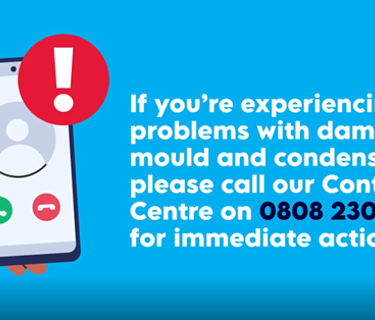Damp and mould cases affect millions of homes in the UK, and social landlords have been changing the way they deal with the problems in residents’ homes.
Over the past couple of years, we’ve been working hard to make changes to the way we deal with damp and mould – from the ways you can report it, through to timescales and staff training across the organisation.
Damp and mould awareness week allows us to have a look back at the changes we’ve made and how you can report any damp and mould issues to us.
New damp and mould team
We’ve created a dedicated damp and disrepair team who specialise in damp and mould cases, this was brought in two years ago headed up by our Damp and Disrepair Manager Sean Watson, who oversees a team of two Damp and Disrepair Supervisors and are supported by a Damp and Disrepair Coordinator.
AiCO Environmental sensors pilot
We have organised a pilot to test the use of AiCO Environmental Sensors . The devices monitor temperature humidity and air quality in the property. They can detect when properties are at risk of damp and mould and will be provide an additional tool for us to help address the causes of damp in our properties. They also come with a Homelink Resident App which enables residents to monitor air quality in their home and view any issues identified.
If you are interested in being part of this pilot, please contact the Health and Housing Project team on 08082306500 or via email; healthandhousing@pch.co.uk
New reporting system
We’ve introduced a new triage reporting system to help prioritise our response to reports of damp and mould. We work to a 14-day response time for low level reports of damp and mould and 7 days for reports of more severe cases. We determine the levels of severity using our triage tool. During the colder months we can receive up to 60 reports a week, so it’s key that we tackle those worst cases and cases where there are additional needs or vulnerabilities first.
Staff training
We put together a series of training modules for staff right across the organisation and not just those who deal with the damp and mould in people’s homes. All staff should now know how to spot damp and mould, when to report it and should be able to offer advice on how residents can get rid of it.
Raising awareness and promoting reporting
We’ve promoted information on damp and mould and how to report cases as well as dealing with low level mould problems regularly in our quarterly magazine, our e-newsletter, on our website and via social media. We’ve created an animation for residents explaining all the information they need, and we’ve also updated our damp and mould leaflet.
Resident Review
A group of residents were tasked with looking at the way we tackle damp and mould cases and after reviewing all of our information and carrying out interviews with staff across the organisation, made recommendations for improvements and presented them to our Customer Focus Committee. All of their recommendations were implemented. We will be publishing the findings of the report and the recommendations shortly.
Ian Howse, Head of Repairs at PCH, said: “We take damp and mould very seriously as it can have a hugely negative impact on people’s health, as well as making it unpleasant and uncomfortable living in your home, and we are doing everything we can to respond promptly and tackle issues when they are reported to us.
“We are prioritising a response to our most vulnerable residents, with the triage system able to highlight those residents who have vulnerabilities or underlying health issues that can be adversely impacted by the presence of damp and mould.
“We want our residents to know that every case that’s reported is dealt with promptly, professionally and we will continue to offer help and support to our customers until the problem is resolved.”
There is information on our website about the new damp and mould reporting standards to help explain how PCH prioritises cases and responds in different time frames, from 24 hours for an urgent, category-one hazard to longer time frames for more routine repairs.
You can find all the information on our website here.




